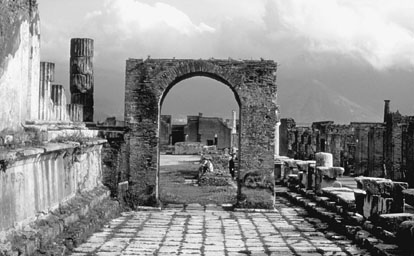

 | Page 1059 |  |
installations scattered around the perimeter. The site has been intensively excavated for 250 years, with work only occasionally overshadowed by that at other sites nearby, particularly herculaneum. Some one-third of Pompeii remains unexcavated.
Excavations in the eighteenth century uncovered the theater, the Temple of Isis, and a number of other important structures in the western part of the town. The first plan of the site was produced in 1778, and Pompeii was firmly incorporated into the itinerary of the grand tour. Complaints about the conduct of the excavations began almost immediately (and have continued virtually unabated). The worst excesses probably occurred in the first half of the nineteenth century, when teams of up to 1,500 men began vast clearances. The excavations and the works of art they produced were sources of great pride for the Bourbon kings of Naples and were used extensively for political purposes. The main public areas emerged in this period (the Forum, the amphitheater), along with a number of luxurious houses. The houses were often cleared to a point at which the final uncovering of the wall paintings and mosaics could take place in the presence of visiting dignitaries, after whom the houses might then be named. These excavations were not conducted stratigraphically, and the documentation (especially regarding the objects found in the structures) was poor.

An arch and walkway in the ancient Roman city of Pompeii
(Image Select)
Some methodological improvement arrived in 1860, when the Bourbon kings were ousted and Giuseppe Fiorelli was appointed director of excavations for the newly unified Italian state. Although some contemporaries criticized Fiorelli’s methods as lacking the appropriate intellectual and aesthetic ambition, the director’s general approach and his establishment of a school of archaeology in Pompeii brought a new professionalism to the excavations. It was Fiorelli’s idea to pour plaster into the cavities left by perishable material, which decayed only after volcanic ash had hardened around it, allowing the recovery of the shapes of humans, animals, furniture, and even tree roots. It has been estimated (though not very reliably) that 2,000 people perished in the eruption of a.d. 79 at Pompeii. Many residents escaped, and the town may already have been partially abandoned as the result of seismic activity in the decades preceding the final eruption. Pompeii is
 |  |